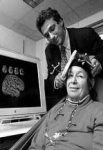Mar 13, 2006
Transcranial magnetic stimulation
Via Medgadget
 From Yale School of Medicine:
From Yale School of Medicine:
"It appears that stimulating populations of neurons once per second with Transcranial Magnetic Stimulation over many minutes modestly reduces the capacity of these neurons to activate each other," Hoffman said [Ralph Hoffman, M.D., a professor in the Department of Psychiatry and lead investigator of the study -ed.] "As a result, neural populations as a whole become less reactive or excitable. Our study findings suggest that hallucinations can be curtailed using this approach without interfering with normal brain function."
Hoffman recently completed a study testing TMS in different areas of the brain and found that positioning the TMS over what is known as Wernicke's region in the left temporal lobe, and a second region located on the opposite side of the brain, were optimal in reducing these hallucinations. He said these two brain areas, which ordinarily play key roles in perceiving words spoken by other persons, have also been found in other studies to be important in producing hallucinated "voices."
For patients enrolled in the trial, TMS will be administered to these brain areas once per second for 16 minutes daily over a three-week period. One-third of the subjects in the trial will start out receiving a placebo form of TMS. After three weeks, these subjects will also be offered a trial of real TMS. The study will use a magnetic resonance imaging brain scan to precisely position TMS over desired brain regions.
21:28 Posted in Neurotechnology & neuroinformatics | Permalink | Comments (0) | Tags: Positive Technology







The comments are closed.